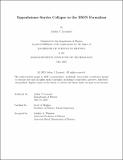Oppenheimer-Snyder Collapse in the BSSN Formalism
Author(s)
Leonard, Aidan J.
DownloadThesis PDF (1.140Mb)
Advisor
Hughes, Scott A.
Terms of use
Metadata
Show full item recordAbstract
In general relativity, problems with high degrees of symmetry often serve as illustrative simplifications of complicated scenarios. Oppenheimer-Snyder collapse, an exact solution for the gravitational collapse of a uniform, pressure-less ball of dust into a black hole, provides valuable insight into the collapse of realistic mass distributions such as stars. Early numerical relativity simulations demonstrated that a rotating ball of dust collapses into a Kerr black hole. In this thesis, we formulate the collapse of a slowly rotating dust-ball using the BSSN framework from numerical relativity, with the aim of reproducing this result in a simple manner. By perturbing the Oppenheimer-Snyder solution in isotropic coordinates, we find semi-analytic solutions to the constraint equations at linear order in angular momentum. In addition, we develop a Mathematica simulation code for modeling of spherical vacuum systems using the BSSN formalism. Diagnostics provide comparison of our results with theoretical predictions for the simplified case of a stationary black hole. Further work is required to introduce matter terms and move from spherical to axial symmetry.
Date issued
2025-05Department
Massachusetts Institute of Technology. Department of PhysicsPublisher
Massachusetts Institute of Technology